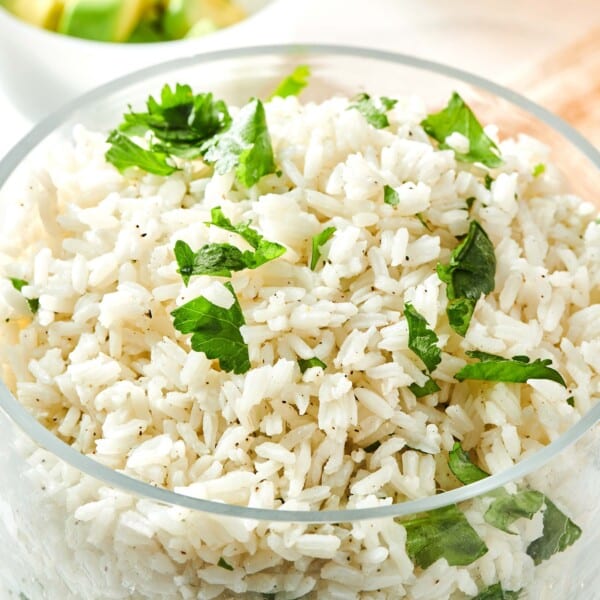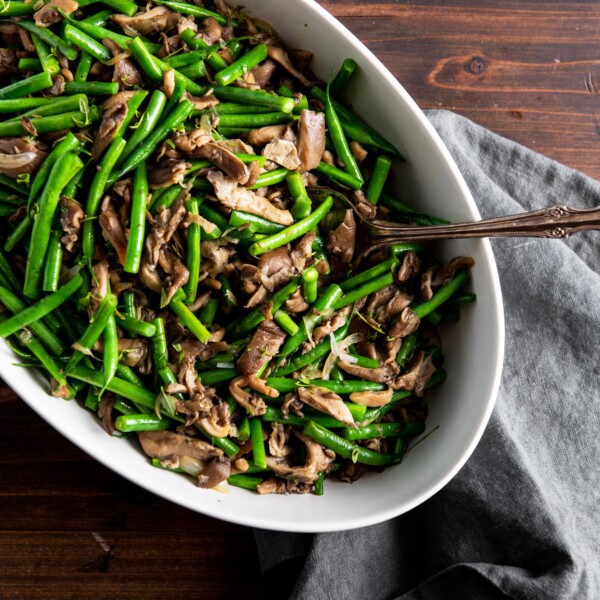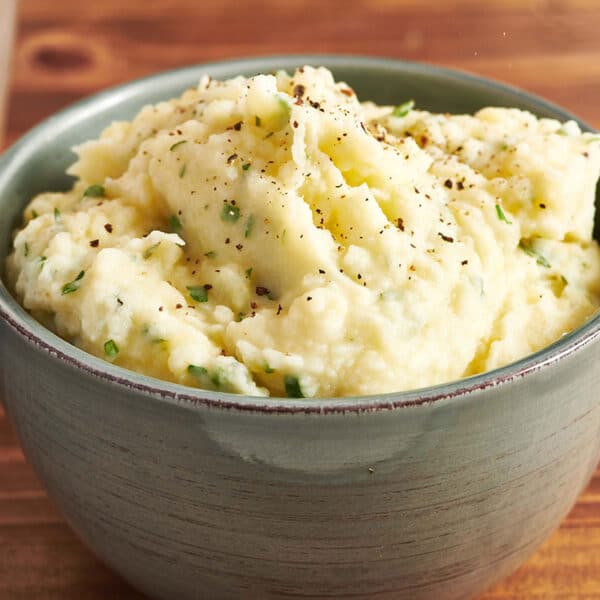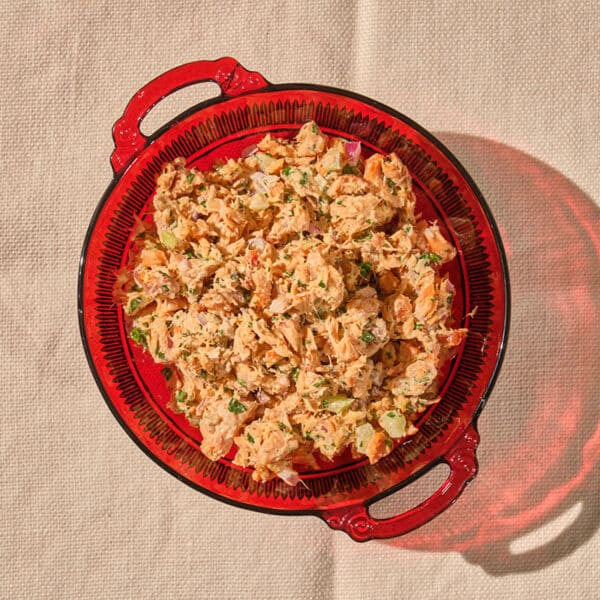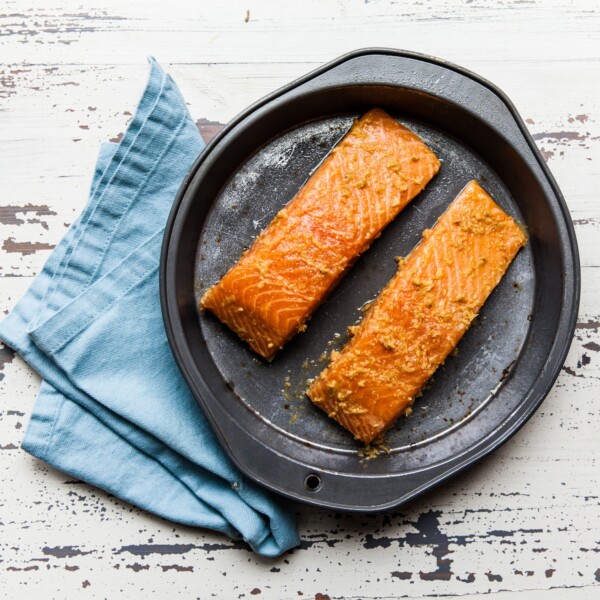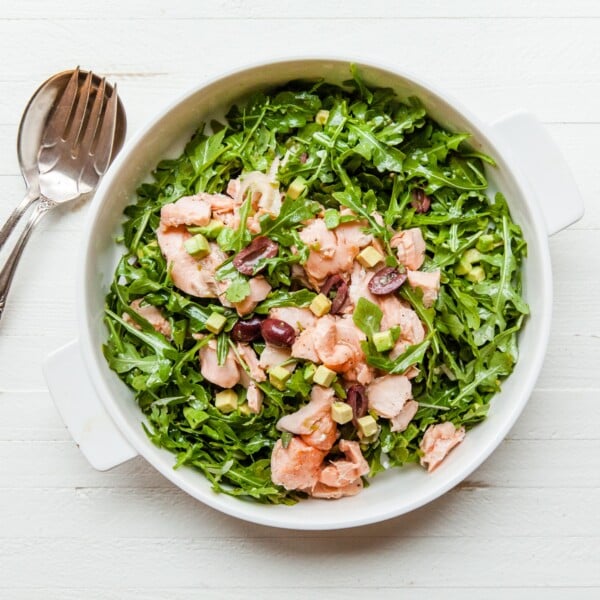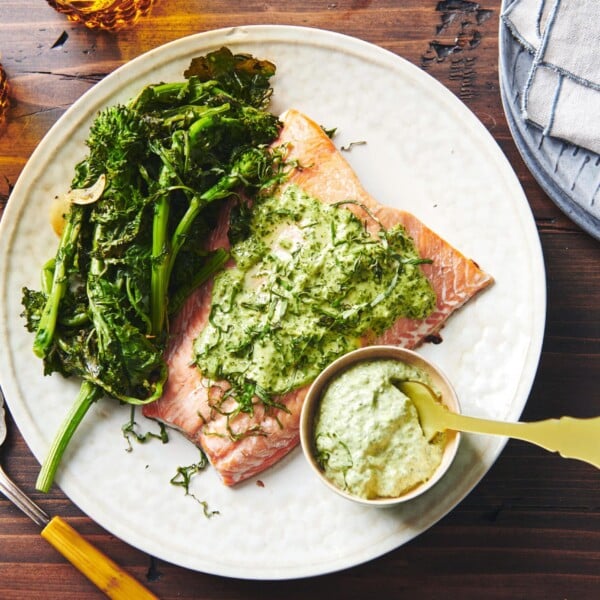Crispy-Skinned Salmon with Dill Sauce
on Apr 27, 2024, Updated May 27, 2025
This post may contain affiliate links. Please read our disclosure policy.
This classic fish and sauce pairing is ideal for special occasions or weeknight dinners, and takes about 30 minutes to make. The crispiness of the skin is an amazing contrast to the richness soft salmon.
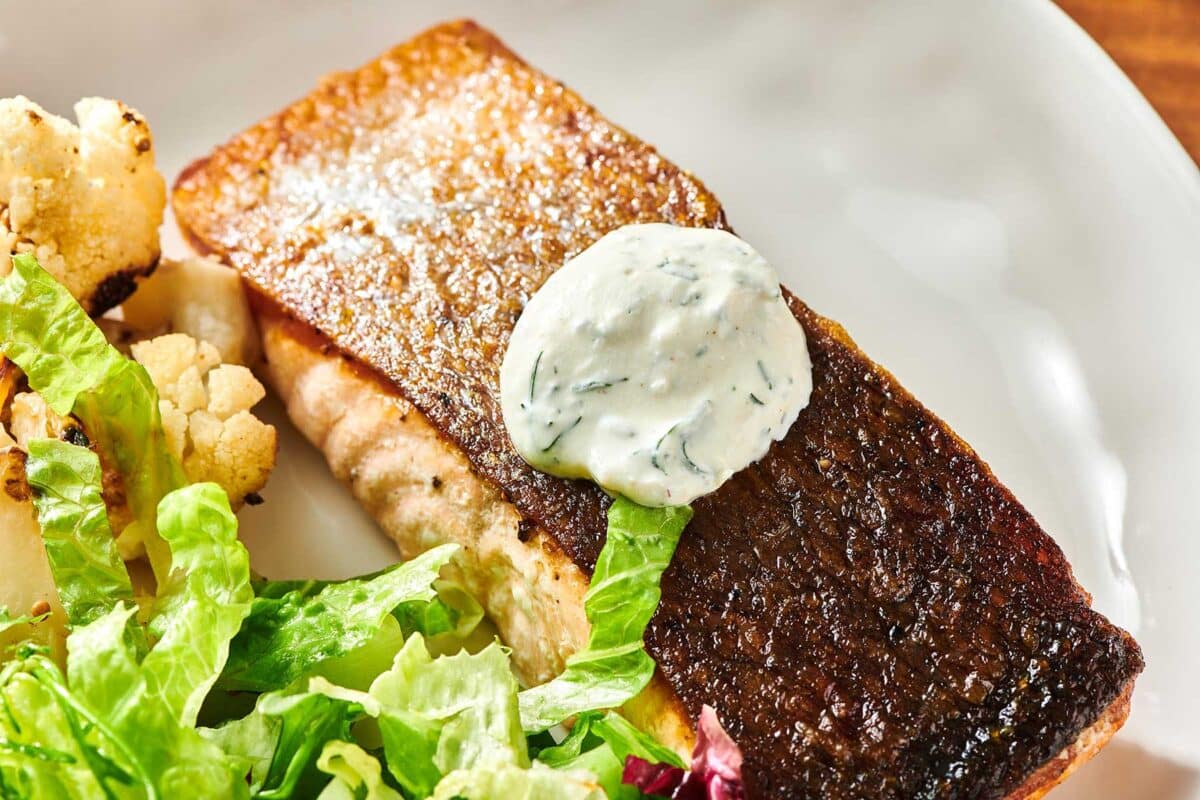
This is one of the most classic and delicious ways to serve salmon, a perfectly cooked filet with a crunchy, crispy skin napped with a lovely herb sauce. It’s a fantastic pairing, with the lush yet light, creamy yet fresh dill sauce matching up perfectly with the rich fish.
There is a reason that salmon with dill sauce appears on menu after menu — it’s downright delicious. And because dill sauce is so easy to make, and salmon is so simple to prepare, this sophisticated dish is highly doable on a weeknight, though obviously elevated enough to serve guests. This is one of the most classic fish/sauce pairings in the U.S. (and maybe parts of Europe). In the recipe, salmon is pan-seared to get a crispy skin, but you can also use the sauce on grilled, poached, roasted, or baked salmon. The sauce could be served with other types of fish, too; fresh or smoked trout is another popular pairing with dill sauce.
By signing up, you agree to our Privacy Policy.
Think of this on Valentine’s Day, Mother’s or Father’s Day, New Year’s Eve, or to impress that awesome person in your life with a home-cooked meal that feels very special.
What's In This Post?
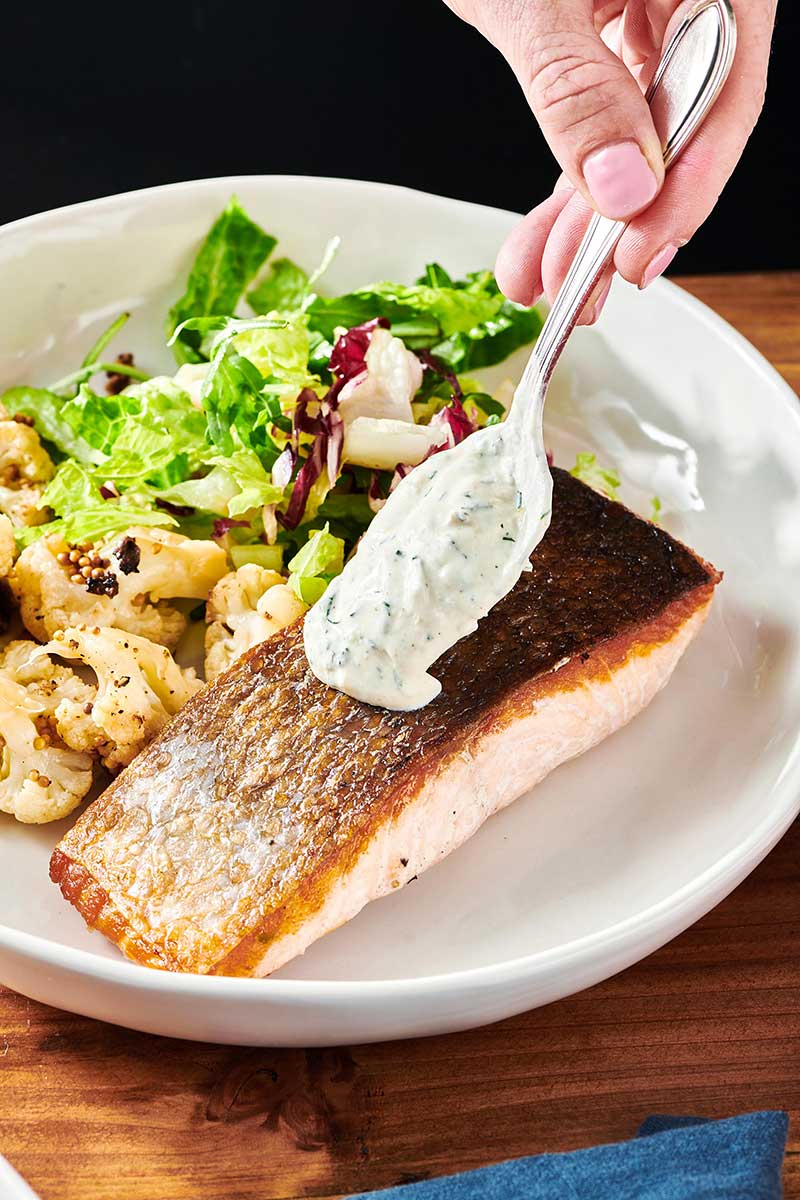
Crispy-Skinned Salmon with Dill Sauce is a classic dish ideal for special occasions or weeknight dinners. This recipe shows how easy it is to make at home.
Ingredients for Salmon with Dill Sauce
- Salmon fillets – Choose filets that are about the same size so that they cook evenly. And make sure they have the skin still on!
- Salt and pepper – To taste.
- Olive oil – It doesn’t take too much oil to fry the salmon skin into a perfect crispy crunchy exterior.
- Dill sauce – This gorgeous sauce features a sour cream base seasoned with lemon, mustard, garlic, and fresh dill.
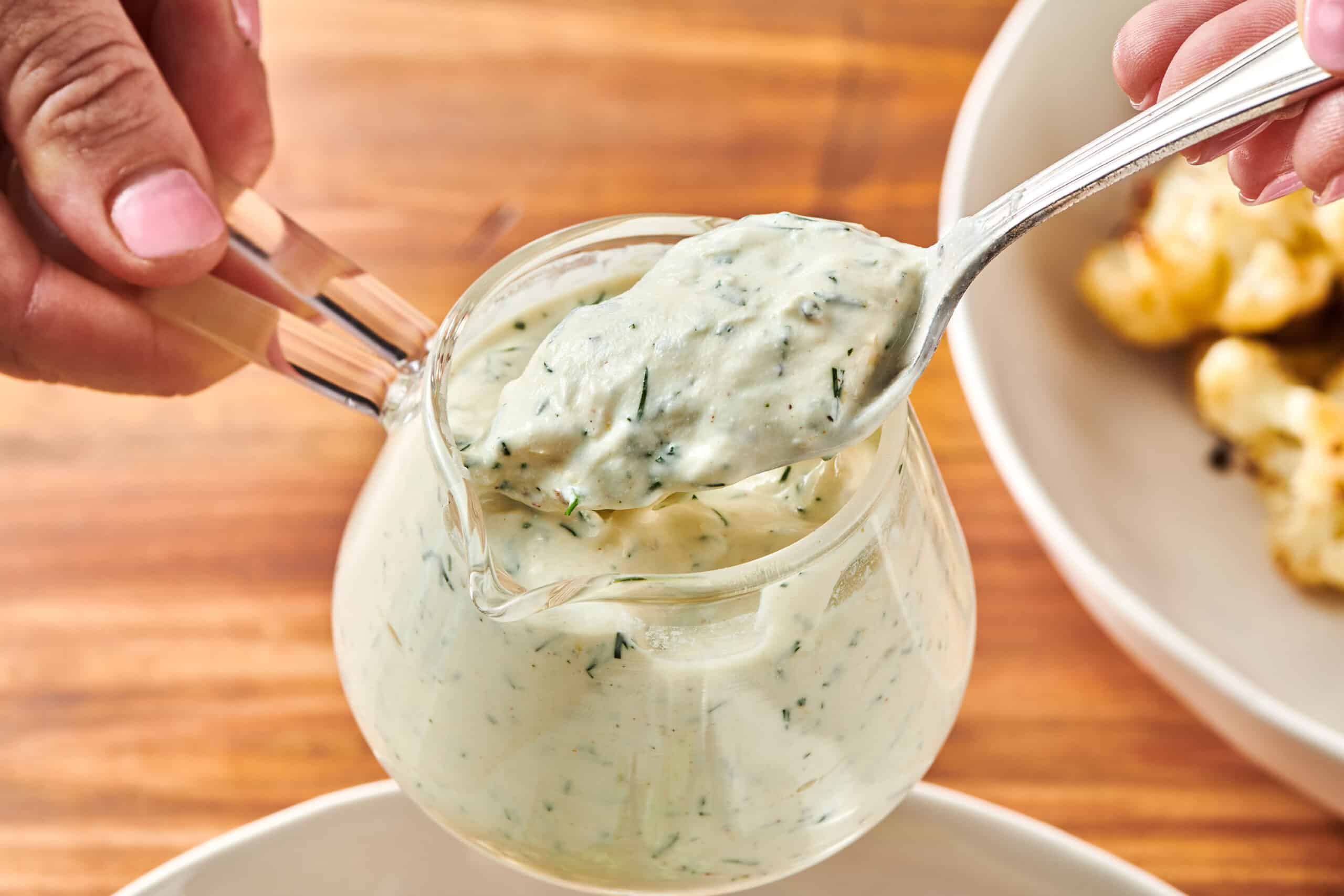
How to Know When Salmon Is Done
How well-done you like your salmon is completely personal and should not be judged by anyone at any time. If someone is telling you that you should like your salmon cooked a certain way, then politely tell them, “Good for you! Not for me.” It’s a sentence I learned listening to Amy Poehler’s memoir Yes, Please!, and one which I think applies to cooking and eating in general.
The basic adage for how long to cook fish is 10 minutes per inch. It’s a good starting guideline no matter how you cook your fish: in a pan, on a grill, poaching, roasting, broiling, etc. But this is just a starting point and not a firm rule.
Salmon can definitely be pink in the middle and still be safe to eat. But rare salmon is not everyone’s cup of tea, so if you are cooking for a crowd, aim somewhere in the medium range. Or, if you feel confident and have the time, you might ask folks how they like their salmon cooked. Make sure your salmon is very fresh, especially if you are serving it on the medium-rare side with a substantial amount of translucent pinkness in the middle.
Internal Temperatures for Salmon
- Medium-rare salmon should be a bit translucent in the center but opaque on the top and the bottom. The internal temperature (using an instant-read thermometer) will read between 120 and 125 degrees.
- Medium salmon will be a bright dark pink in the center but not quite translucent. An internal temperature will read between 125 and 130 degrees.
- Medium-well salmon will be opaque pink throughout. The temp will be around 130 to 135 degrees.
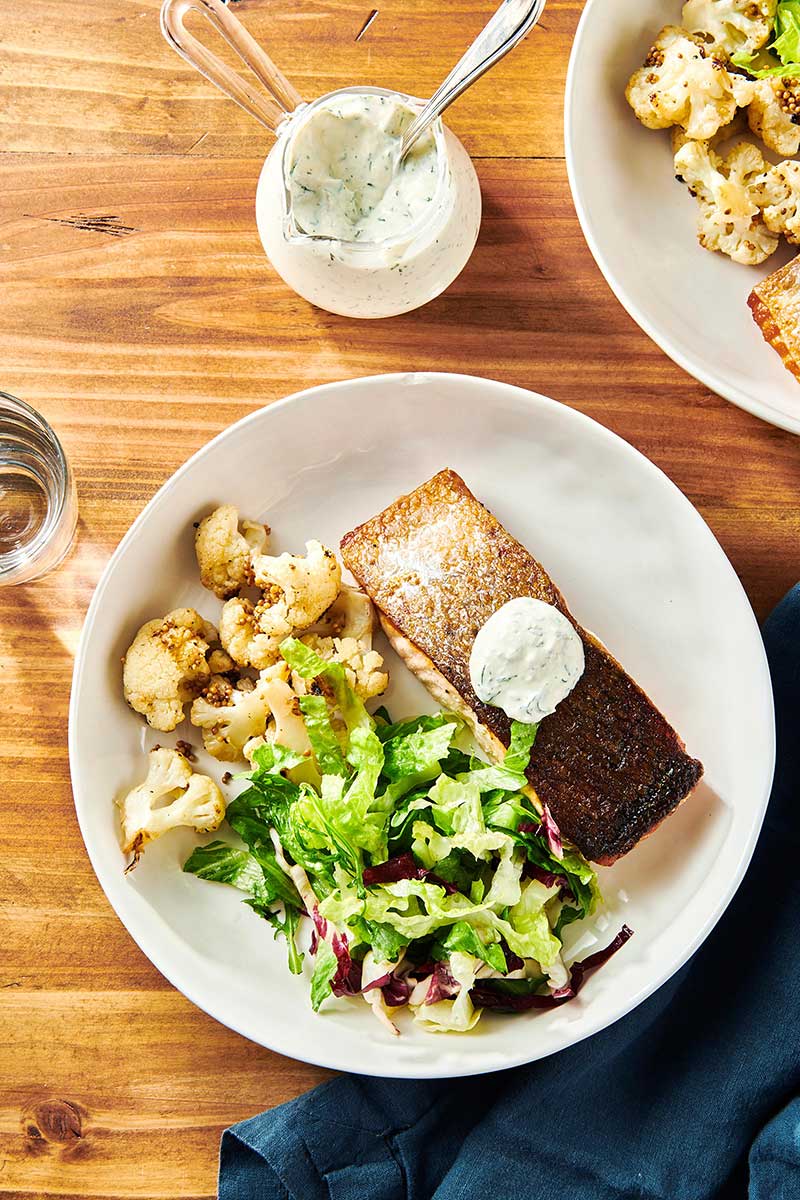
Cooking Tips for Crispy-Skinned Salmon
- Make sure the fish and the skin look very fresh, with no tears or discoloration in the skin.
- When you place the salmon in the pan, place it skin-side down. Give the fish a little shuffle as you place it in the pan, so the entire skin side gets coated with oil, which will prevent it sticking to the pan.
- Then don’t move it! Lifting the fish too often will hinder the skin’s ability to get crispy before the fish is cooked to your liking.
- No matter how you like your salmon cooked, don’t forget about carryover cooking. This is the name for the additional cooking your fish will do once it’s removed from the pan because of the residual heat in the fish itself. The temperature will go up slightly, and the fish will cook a bit more in the couple of minutes after you remove it from the heat.
- Take carryover cooking into account when you decide when to remove the fish from the pan (and know that if the fish sits in the hot pan after you take it from the heat, it will definitely continue to cook more).
- Serve the salmon skin side up, which prevents the skin from steaming on the plate and becoming soggy. Flip the salmon carefully as soon as you remove it from the pan to keep the skin crisp.
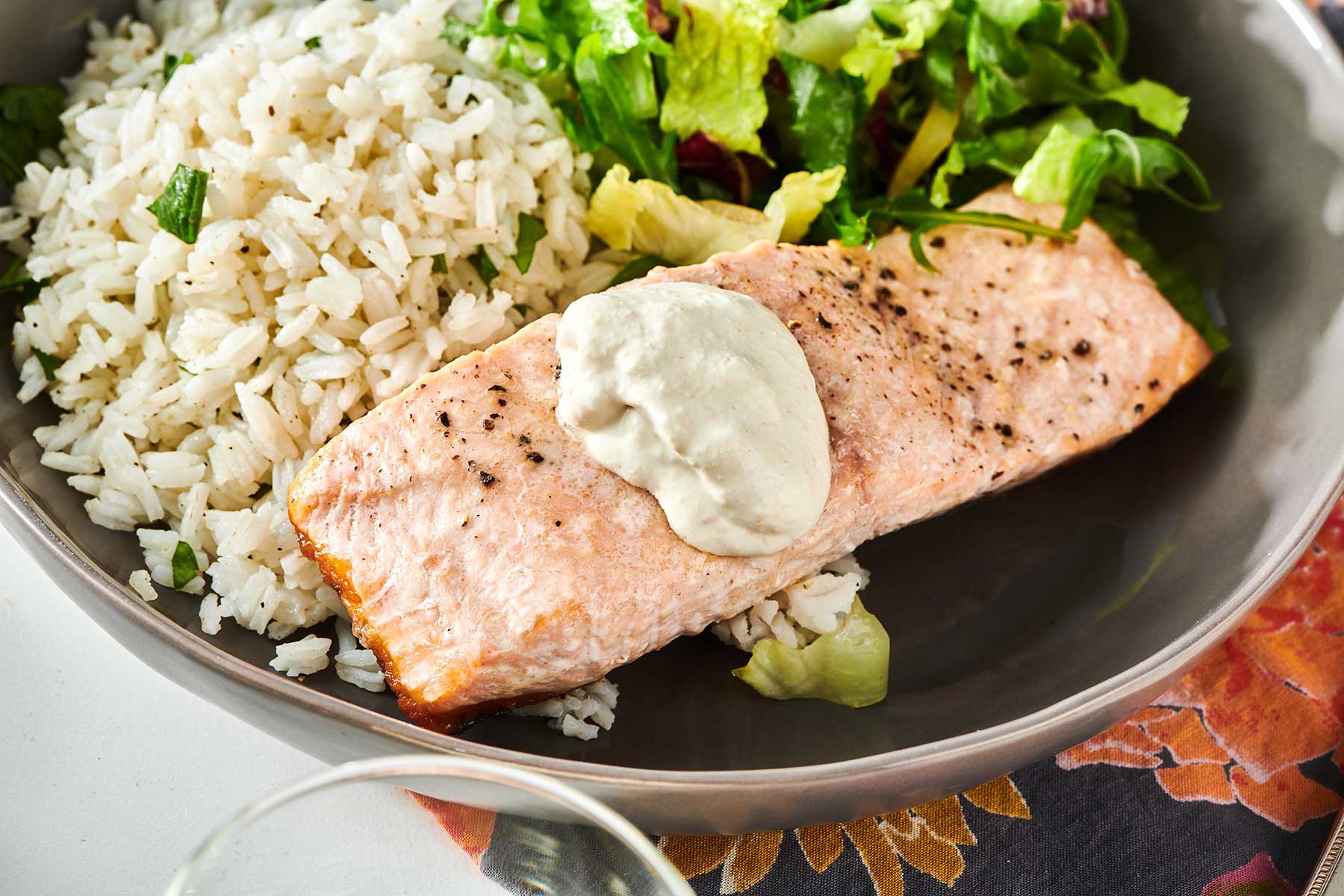
How to Make Crispy-Skinned Salmon
I finally found a great method for cooking crispy-skin salmon on the stove without it falling apart. For starters, obviously, make sure you buy salmon with the skin still on. Note this method works for other fish filets with skin as well. There are different ways to go about this, but the following is the most foolproof way I’ve found. This method involves leaving the filets be and not flipping them, which is where things start to fall apart (in some cases, literally!).
- Season the salmon: Generously season the fish with salt and pepper.
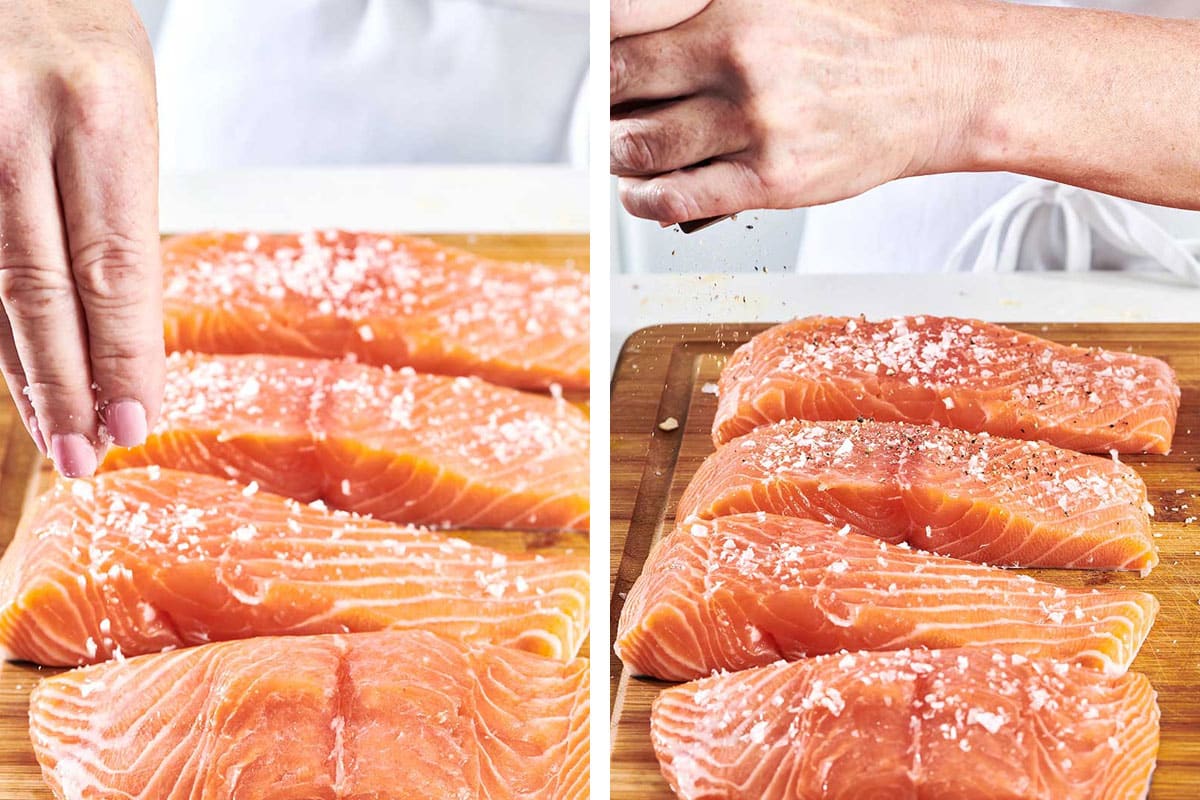
- Sear the skin: Heat up the oil before you start to cook the salmon. Once it’s nice and hot, add the salmon skin-side down and cook about 4 minutes.
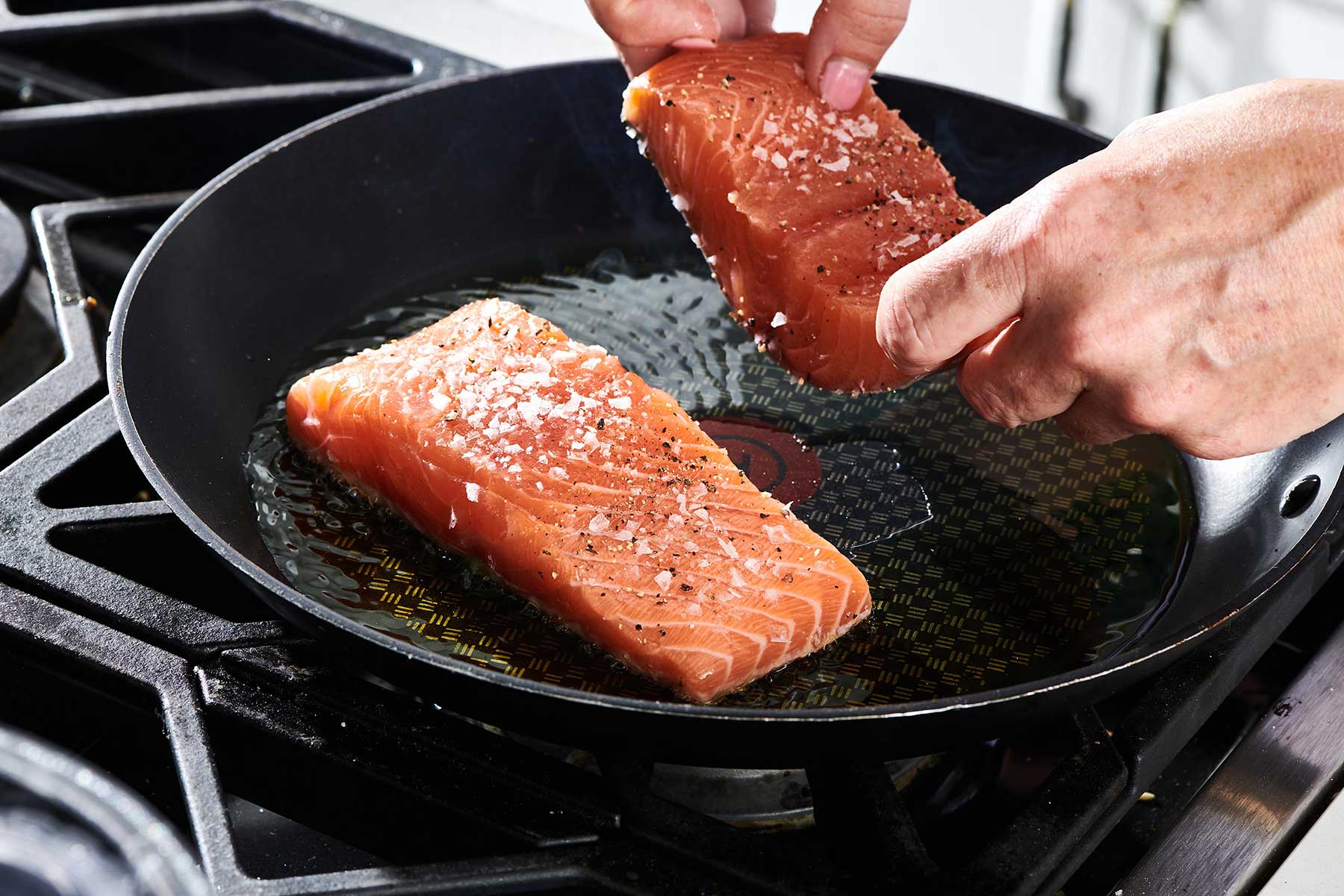
- Finish cooking: Reduce the heat and cover to cook for another few minutes until the salmon is cooked. For a more medium-rare salmon, go for 3 minutes. For a well-done piece of salmon, cook for up to 8 minutes. The skin will get nice and brown and crispy, and the interior of the salmon should be moist and flaky.
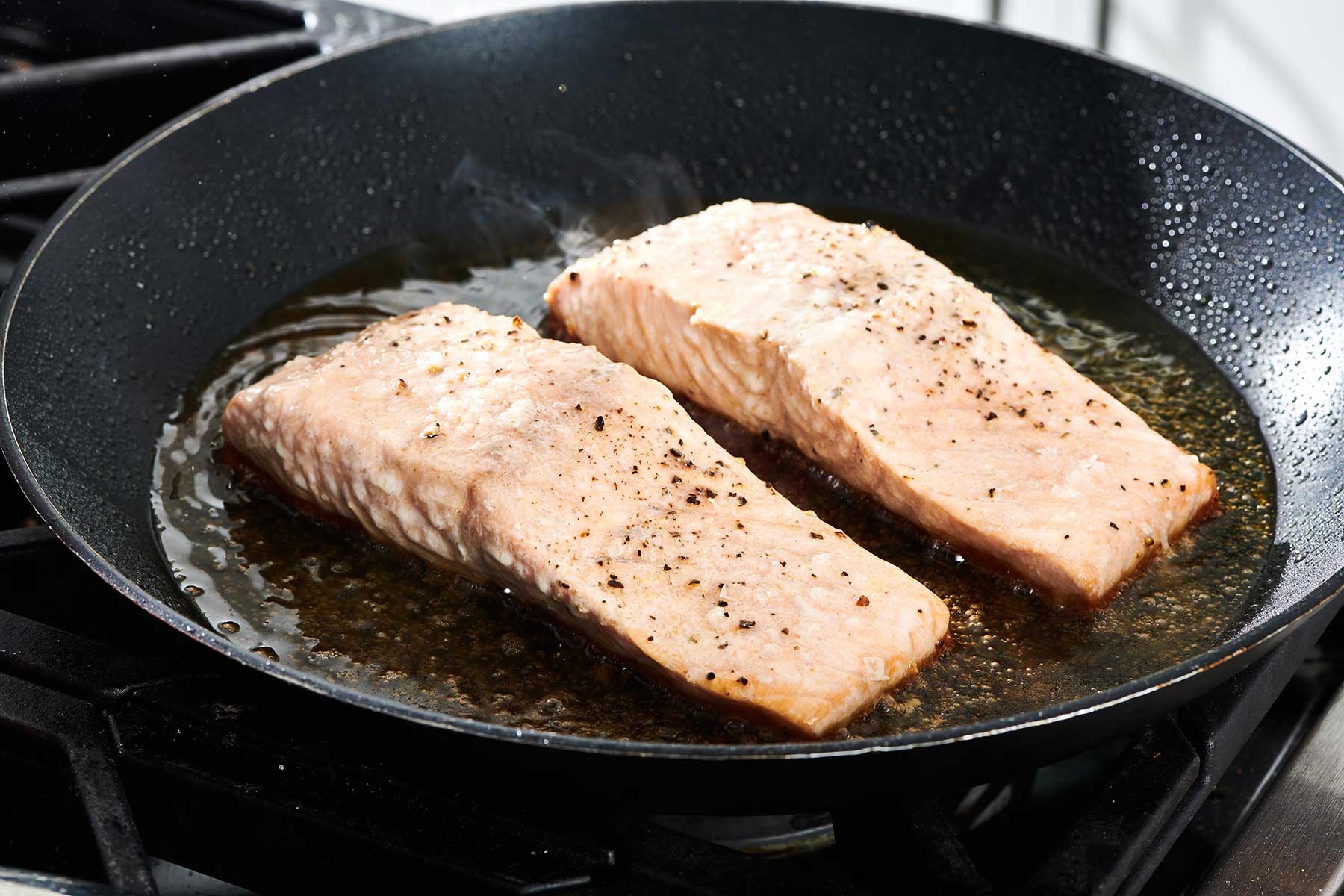
- Serve: Serve skin side up, hot or warm, with the dill sauce.
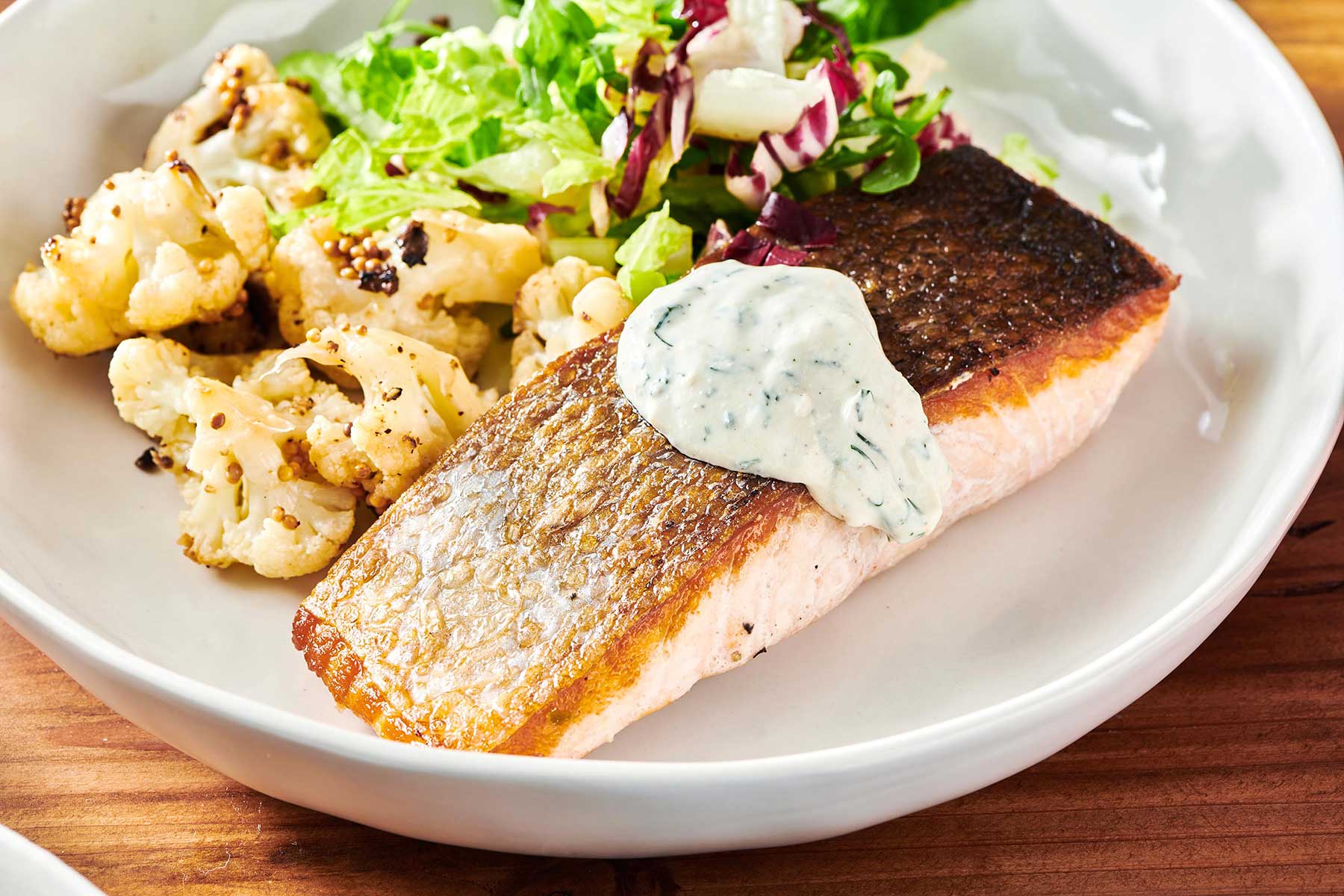
FAQs
Salmon skin is delicate and can get soggy easily. Often the problem is that your pan wasn’t hot enough to crisp up the skin. Sometimes, if you cover the fish during or after cooking, the skin can absorb the steam and lose its crispiness. Make sure to give it a few seconds uncovered at the end of cooking to preserve the crispy skin, then rest it uncovered with the skin side up until serving. Serve skin side up so it stays crisp.
I like to use olive oil for its depth of flavor, which pairs nicely with the mild but fatty salmon. Any type of neutral oil would also work for getting your salmon skin nice and crispy.
What to Serve With Salmon and Dill Sauce
This would be great with a side of Zucchini Orzo Casserole.
More Sauces for Salmon
Pin this now to find it later
Pin It
Crispy-Skinned Salmon with Dill Sauce
Ingredients
- 4 (6 to 8-ounce) salmon fillets (skin on)
- Kosher salt and freshly ground black pepper (to taste)
- 2 tablespoons olive oil
- Dill sauce
Instructions
- Pat the fish dry and season with salt and pepper.
- Heat the oil in a large, heavy skillet (preferably nonstick) over medium-high heat. Place the salmon (in batches if necessary) skin side down into the pan and cook for about 4 minutes, giving the filets a little shuffle as you lay them in the pan so that the skin doesn't stick to the bottom.
- Reduce the heat to medium and cover the pan. Let the salmon cook for another 3 to 8 minutes or so until it is cooked to your liking. Remove the lid, and let cook for another 30 to 60 seconds to recrisp the skin on the bottom. The skin should be browned and crispy, and the middle of the salmon should have a bit of translucent or deep pinkness inside (if you prefer your salmon cooked through; then give it another minute or two). Remember the salmon will continue to cook a bit once removed from the heat.
- Serve hot or warm, skin side up, with the dill sauce.
Notes
- Medium-rare salmon should be a bit translucent in the center but opaque on the top and bottom. The internal temperature (using an instant-read thermometer) will read between 120 and 125 degrees.
- Medium salmon will be a bright dark pink in the center but not quite translucent. An internal temperature will read between 125 and 130 degrees.
- Medium-well salmon will be opaque pink throughout. The temp will be around 130 to 135 degrees.
- Make sure the fish and the skin look very fresh, with no tears or discoloration in the skin.
- When you place the salmon in the pan, place it skin-side down. Give the fish a little shuffle as you place it in the pan, so the entire skin side gets coated with oil, which will prevent it sticking to the pan.
- Then don’t move it! Lifting the fish too often will hinder the skin’s ability to get crispy before the fish is cooked to your liking.
- No matter how you like your salmon cooked, don’t forget about carryover cooking. This is the name for the additional cooking your fish will do even once it’s removed from the pan because of the residual heat in the fish itself. The temperature will go up slightly, and the fish will cook a bit more in the couple of minutes after you remove it from the heat.
